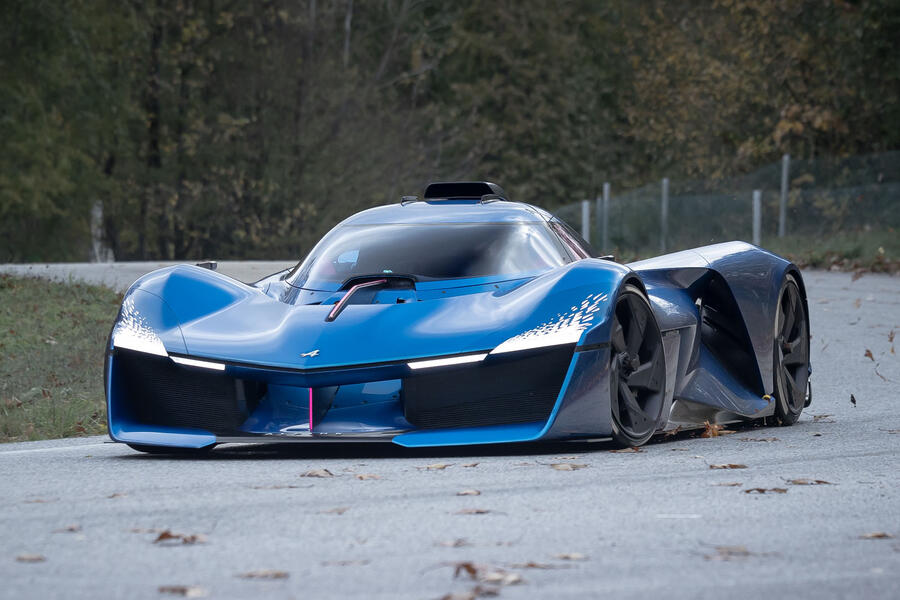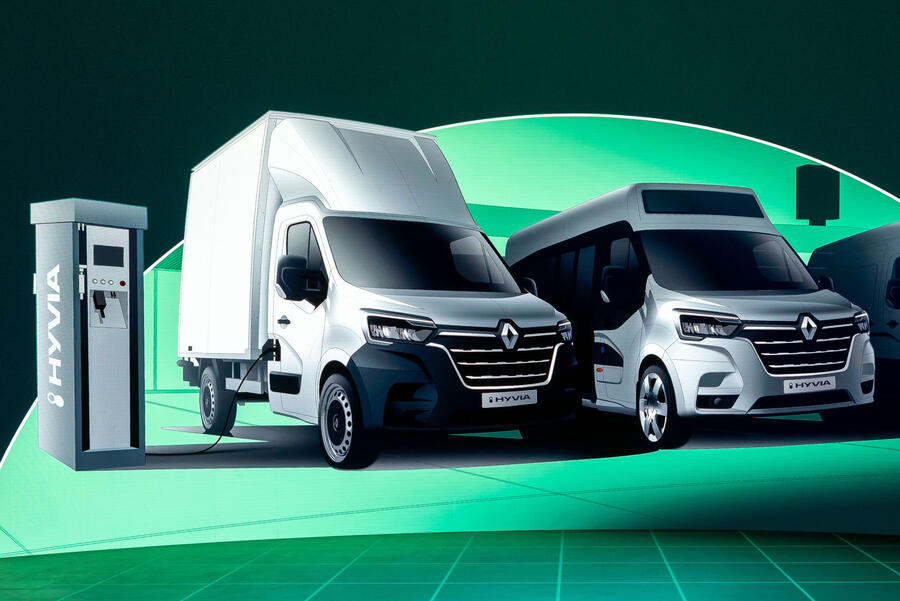Alpine is exploring the possibility of putting the extreme Alpenglow concept into limited production as a road-going supercar with a hydrogen-combustion engine.
First shown in 2022, the Alpenglow recently nudged closer to a potential production car when it became the Hy4 – a rolling prototype fitted with the French brand's first hydrogen combustion engine.
It was due to conduct its first public demonstration at the recent World Endurance Championship round at Spa-Francorchamps, Belgium, but failed to start. This was due to an electrical fault, Alpine said.
Speaking to Autocar before the ill-fated test, Alpine design chief Antony Villain strongly hinted at the prospect of it becoming a production car.
“When we designed the [Alpenglow] we had two fields in mind: the production car and the racing car,” said Villain.
He explained that the concept was initially designed in parallel with the firm’s Le Mans Hypercar racer, the A424, but has become even more road-focused in its most recent evolution.
For example, the Hy4 ditched the original single-seat interior in favour of a more conventional two-seat configuration. This is because the new car is underpinned by a Ligier LMP3 racing chassis, rather than the concept’s bespoke frame.
Commenting on the Alpenglow’s prospects of making it to production, Villain said: “Why not? Why not have that on the roads? We want to keep both ways [hydrogen-combustion and battery-electric] possible. Maybe we could do a little series of these cars for the road. That could be just right.”
![]()
Villain added that the process of turning the Alpenglow into a viable production car had been considered from the outset of the project. “We have already got these steps in mind, and the next steps,” he said.
He said that “it’s more of a programme rather than a car” and that “the next one will be another evolution, styling-wise, with more and more credibility”.
Key to the Alpenglow’s progression is the ongoing development of a new V6. Unlike the engine in the Alpenglow Hy4, which is a four-pot sourced from motorsport firm Oreca, it's being worked on entirely in-house at Alpine.
The priority for the V6 is improved efficiency. According to Alpine, the Hy4 is capable of driving around 62 miles at race pace between fill-ups.
Racers at the 24 Hours of Le Mans – which will include a hydrogen-combustion class for the first time in 2027 – typically complete 10 to 20 laps of the nearly-8.5-mile circuit before they pit for fuel.

Alpine also plans for the V6 to put out more power than the Hy4’s turbocharged 2.0-litre unit, which makes 335bhp.
Although the V6 is being developed with a view to eventually go racing, it’s possible that it could also be deployed on a road car, thanks to user-friendly power delivery.
“It’s not going to be an F1 engine revving very very high,” said François Champod, Alpine’s director of racing vehicles. He added that it would drive comparably to existing petrol engines.
But that isn't to say that it would drive identically. Pierre-Jean Tardy, Alpine’s chief hydrogen engineer, told Autocar that the nature of hydrogen would bring some key differences.
He explained: “From the passion point of view, it’s almost the same sound, almost the same response. However, there could be some elements that could bring a difference to the response.
“Running clean on hydrogen means that you have to make sure that your NOx emissions will be low. Low NOx emissions – and also for efficiency – you want to run lean, and leaner than for gasoline.
![]()
“Running lean with hydrogen produces lower-temperature exhaust gas, which means that for a turbocharger, [you have to work the compressor harder] with less energy available on the turbine. There’s a sort of imbalance between the turbine and the compressor, which is even higher than on a diesel engine. This could cause some lag time problems that you will have to get around by other means.”
Tardy added that mitigating engine knock is also a big challenge for hydrogen engines, because hydrogen is flammable over a wider range of fuel-to-air concentrations than petrol is. Hydrogen burns at concentrations from 4% to 76%, whereas petrol vapour ignites from 1.4% to 7.6%. This means that – within a single combustion chamber – the mix of hydrogen and air can simultaneously be lean and rich.
“We will learn from this engine how that works, how to improve the combustion process and how to improve the mixture preparation,” said Tardy.
![]()
He explained: “It’s much more difficult to properly mix a gas like hydrogen with a gas like air – gas-to-gas – than with gas droplets [vapour] in air. This isn't easy to figure out, but it’s the truth. Especially when hydrogen comes out of the injector: it comes with a massive velocity, and that makes it more difficult to mix properly with air.
“The more you increase the speed of the engine, the less time you have to inject. The more you increase the power, the more thermal load you have. So you also have more risk of abnormal combustions [knock].”
This creates issues not only in cooling the engine but in ensuring that you manage temperatures “homogeneously” in each combustion chamber.
Several Alpine executives conceded that the hydrogen-combustion project was still at an early stage. The new V6 recently entered dynamometer testing, and the brand has committed to it powering the Alpenglow by the end of this year.
Alpine is expected to enter a hydrogen-combustion car into the 24 Hours of Le Mans in 2027, but it has yet to make a firm commitment to the event. It said in a statement that it's “paying close attention to changes in competition regulations”.
As for when a hydrogen-burning road car could be ready, Champod said: “It’s early days, it’s going to be research years. For the road, it’s not all in our hands. It’s all about infrastructure and these kinds of things. So I can’t really say how far it’s going to progress.”

Villain said hydrogen “could be for a very limited number of cars”, given the existing limitations to the global hydrogen filling network. However, he also pointed to the Renault Group’s joint-venture for hydrogen-fuel-cell vans, Hyvia, as a means for infrastructural development that could support the launch of a road car.
He added: “Probably the network will be driven by trucks and LCVs, because there will be a lot of need for trucks everywhere in Europe to get a network of hydrogen. That could help us, because of course it doesn’t make sense to develop a network just for a sports car. The next phase will be driven by trucks and LCVs, and we will probably benefit from this.
“Afterwards, it’s a matter of storage, either gas or liquid, because the tanks take up a lot of space: more than 350 litres of gas instead of 50 litres of petrol, so we have to package all this in the car.”
Further complicating the infrastructural element is that Alpine feels the use of hydrogen is only justified when it is decarbonised – either ‘blue’ or ‘green’.
Blue hydrogen is made from natural gas, emitting CO2 which is then captured and stored instead of released into the atmosphere. Green hydrogen, meanwhile, is made by electrolysing water with renewable electricity, without any carbon emissions.
According to a January 2024 report by consultancy McKinsey, “nearly all” new hydrogen production is expected to be “clean” from next year.
Villain said: “Green hydrogen is mandatory, otherwise that doesn’t make sense.”
Tardy followed: “[We will use] any colour which is decarbonised. What we want to do is bring our contribution. Our contribution is typically in the technologies in using hydrogen.”






Join the debate
Add your comment
Wow! Another big step towards our H2 Future!
Even when the multi million pound hydrogen car cannot even do one lap auto car manage to get another article on the hydrogen car folly.
That Wooden spoon is getting too much use, there needs to be choices, not everyone is going to use either due to geographical position.